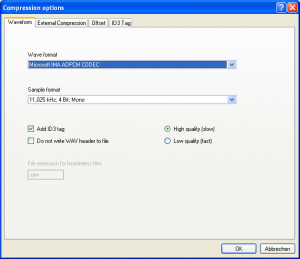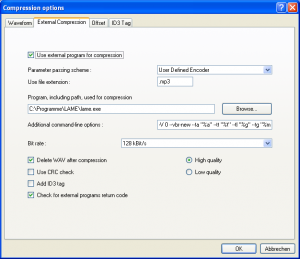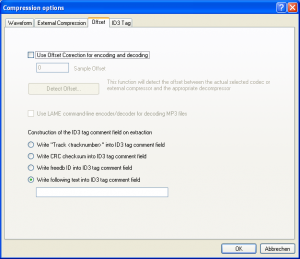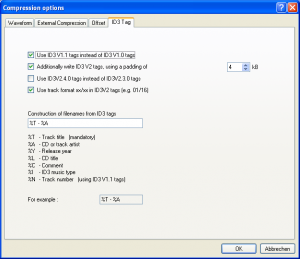EAC Compression Options (Legacy)
In the compression options dialog in EAC (shortcut: F11) all options can be found regarding the compression of music files. Here EAC's behavior when clicking on the MP3 Button in the main window or items in the Action menu (and then starting a compressed action) are specified.
Note that many options are dependent on the codec or external compressor (encoder). So often no clear recommendation can be given. It is just important that you understand what these settings do and how they possibly change the behavior of EAC and/or the codec/external compressor.
Used EAC version: V0.99 prebeta 3
Waveform

This tab offers settings to select a codec installed on your system and the appropriate options to compress WAV files. When you want to use an external compressor, then these options are rather unimportant (see the tab External Compression).
Note that all options are greyed out here if Use external program for compression in the External Compression tab is ticked.
- Wave format
In this drop down box all codecs installed on your system are listed. When new codecs are installed which can compress WAV files, they should show up in this list. The codec to choose depends on what should be achieved with the compression (sample format, compression ratio, etc.).
- Sample format
With this option a sample format (sample rate, resolution, mono/stereo) can be chosen. Which options are available here depends on the codec selected at the Wave format option (e.g. some codecs only support 4 bit resolution). To keep the same sample format as a CD, 44,100 kHz; 16 Bit has to be selected.
- Add ID3 tag
- (Default: disabled, Recommended: enabled)
Some formats (e.g. MP3) support ID3 tags. When this option is enabled, EAC will add these tags to the compressed files (only if the file format supports ID3 tags).
- Do not write WAV header to file
- (Default: disabled)
For playback of some file formats (e.g. MP3), Windows can use a codec designated for WAV playback. In this case, the file should have a WAV header according to the WAV specification (standard RIFF (Resource Interchange File Format) file format structure). This way, it may be possible to play file formats with a program that normally can only read WAV files.
On the other hand, files which are not WAV files should usually not contain a WAV file header. So for other (non-WAV) files, this option should be enabled. Therefore a file extension for headerless files also has to be specified (see option below).
- File extension for header files
- (Default: .raw)
When the Do not write WAV header to file option is enabled, a file extension of the compressed files can be specified here (e.g. .mp3 for MP3 files). If the above option is disabled, this setting gets greyed out automatically.
- Quality setting
- (Default: High quality (slow), Recommended: High quality (slow))
Some codecs support a quality setting to choose between a higher quality of the output files or faster encoding speed. If quality is the only matter, leave this option at the default, which is High quality (slow).
External Compression

In this tab, all options for external compressors can be configured. As all settings are highly dependent on the particular compressor, most settings are only described here because often no clear recommendations can be given.
There are also a few articles with details about how to configure EAC to use particular encoders:
- EAC and FLAC
- EAC and LAME
- EAC and Monkey's Audio
- EAC and Musepack
- EAC and OGG Vorbis
- EAC and WavPack
- EAC and TAK
- Use external program for compression
- (Default: disabled, Recommended: enabled)
To use an external compressor, this setting has to be enabled. Otherwise all the options in this tab are greyed out.
- Parameter passing scheme
EAC comes with a few presets concerning external compressors and the required parameter passing scheme which can be selected with this option (e.g. the Bit rate box will show all available options after a particular compressor was chosen here). But in general, the capabilities of EAC in passing parameters to external compressors are limited. To be not bound to EAC's capabilities, you can use the Additional command-line options for additional parameter passing. When doing so, all these additional command-line options have a higher priority than other settings in this tab (only one exception with the option Add ID3 tag - see below). For example, when you specify a particular bit rate by additional command-line option, then the Bit rate setting will not have an effect anymore. Also a file extension has to be specified with the option Use file extension when a user defined encoder is used.
The usual approach is setting the Parameter passing scheme to User Defined Encoder and specifying all the encoding options by using the Additional command-line options only.
- Use file extentsion
When chosen the entry User Defined Encoder on the setting Parameter passing scheme, a file extension has to be specified here. This should be the extension of the encoded file type (e.g. ".flac" when using a FLAC encoder).
- Program, including path, used for compression
The absolute path to the program used for compression. This may be an .exe or a .dll file (e.g. "C:\Program Files\LAME\lame.exe"). By clicking on the Browse... button, this path can be chosen by a file dialog.
- Additional command-line options
Here additional parameters for the external compressor can be specified. All additional parameters entered here have a higher priority than other options in this tab (e.g. you can override the Bit rate setting by specifying a bit rate via command-line). The only exception of this is the Add ID3 tag option (see below).
To configure the additional command-line options, you can use the following placeholders (taken from the EAC FAQ):
| placeholder | meaning |
|---|---|
| %s | Source filename |
| %d | Destination filename |
| %h…%h | Text "..." only when High quality selected |
| %l…%l | Text "..." only when Low quality selected |
| %c…%c | Text "..." only when CRC checksum selected |
| %r | Bitrate ("32".."320") |
| %a | CD artist |
| %g | CD title |
| %t | Track title |
| %y | Year |
| %n | Track number |
| %m | MP3 music genre |
| %o | Original filename (without temporary renaming) |
| %e | Comment (as selected in EAC) |
| %b | CRC of extracted track |
| %f | freedb ID |
| %x | Number of tracks on album |
So an exemplary command-line could look like this (LAME):
-V 0 --vbr-new --ta "%a" --tt "%t" --tl "%g" --tg "%m" --ty "%y" --tn "%n" --tc "%e" %s %d
As you can see, the command-line options of LAME (e.g. -V 0, --ta, --tt, etc.) are used in conjunction with the EAC placeholders (e.g. %a, %t, etc.) to control LAME only by this command-line.
- Bit rate
What is shown in this dropdown box depends on the Parameter passing scheme selected and specifies the bit rate/quality settings of the external compressor. Note that this option does not have any effect if the bit rate got specified via the Additional command-line options.
- Quality setting
- (Default: High quality, Recommended: High quality)
Many encoders offer the choice between better quality or faster encoding speed. To achieve the best possible quality, make sure High quality is selected.
With this setting it is also possible to configure the Additional command-line option even further: With the placeholders %h…%h and %l…%l you can specify two different settings for the external compressor which can be controlled by this option. The following example (simplified) shows how to use this feature (again with LAME):
%h -V 0 %s %d %h %l -V 5 %s %d %l
If the High quality option is chosen, then then LAME will encode with -V 0, otherwise with -V 5 when Low quality is selected.
- Delete WAV after compression
- (Default: enabled, Recommended: enabled)
If this setting is enabled, EAC automatically delets the extracted WAV file after compression. If you do not need these files (of course the compressed files are kept) after extraction/compression, leave this option enabled.
- Use CRC check
- (Default: enabled, Recommended: disabled)
Some encoders have the ability to store a CRC checksum (cyclic redundancy check) in the resulting (compressed) file. This might be used then to check the consistency of this file during playback. But enabling this CRC check has two major drawbacks: First, this will add 16 bits (the CRC value) on every frame of the encoded file and will possibly increase the file size considerably. Second, many encoders do not support this feature very well because of calculating wrong CRC checksums. So usually players will simply ignore this information. This option also has no effect at all when selected User Defined Encoder at the Parameter passing scheme. Thus having more disadvantages, it is generally recommended to disable this option regardless of the encoder used.
- Add ID3 tag
- (Default: enabled, Recommended: disabled)
When this option is enabled, EAC writes ID3 tags to the compressed files if the file type supports ID3 tags (e.g. when encoding to FLAC, this option will not have any effect, because FLAC uses vorbis tags and not ID3). The settings used (version of ID3, padding, etc.) are determined in the ID3 Tag tab. Another possibility to specify ID3 tagging is to use the external compressor itself to tag the resulting files. This would be done via the Additional command-line options. But note that when this option is enabled, these tagging instructions via command-line do not have any effect, because EAC just overrides the tags written by the encoder.
Generally, it is recommended to disable this option in EAC and let the encoder write the ID3 tags. This way the full tagging abilities of the encoder can be used.
- Check for external programs return code
- (Default: disbaled, Recommended: enabled)
When this setting is enabled, EAC checks the return code of an external compressor. When the external compressor returns an error code (e.g. because of a wrong command-line parameter was used), EAC shows this error message in a dialog box. So it is recommended to enable this option to notice any errors the encoder returns.
Note that there may be some external compressors returning codes which EAC wrongly interprets as error code. If you experience such problems, try disabling this option.
Offset

This tab offers options regarding offset correction during encoding/decoding and the ID3 tag comment field.
Note: The offset mentioned here has nothing to do with a drive offset and therefore should not be mistaken.
- Use Offset Correction for encoding and decoding
- (Default: disabled, Recommended: disabled)
Some encoders will have an offset when encoding. This means that at the beginning of a track they often add some silence, whereas a few samples could be missing at the end. When decoding again, this could result in some unwanted gaps. This options offers now the opportunity to correct this encoding/decoding offset so that the original file can be reconstructed (at least concerning correct beginning/end of a track; with lossy formats the original file can not be reconstructed completely). The point behind this option is that is possible that there is such an offset between the codec which is used for encoding (the actual codec) and the other one used for decoding (default installed codec). An example would be using LAME for MP3 encoding and the Fraunhofer codec for decoding. In this case, this option would be useful.
So when you decode your encoded files and experience some unwanted gaps in the decoded files, then you should try to enable this option and configure it accordingly (see below). In all other cases, leave this option disabled (especially when you encode and decode with the same encoder anyway).
- Sample offset
- (Default: 0)
When enabling the option Use Offset Correction for encoding and decoding, a sample offset has to be entered here. With a click on the button Detect Offset... the correct offset can be recognized automatically.
- Use LAME command-line encoder/decoder for decoding MP3 files
- (Default: disabled)
This option is usually greyed out. To make it available, a LAME executable (lame.exe) has to be placed in the EAC directory. This has to be done manually.
If this option is enabled then, LAME is used automatically to decode MP3 files (Tools -> Decompress...). This overrides EAC's behavior which uses the Fraunhofer codec for MP3 decoding by default.
- Construction of the ID3 tag comment field on extraction
When the option Add ID3 tag in the External Compression tab is enabled, this setting specifies what information should be stored in the comment field. When EAC is not used to tag compressed files and tagging is completely done via command-line parameters, this setting specifies the contents of the "%e" placeholder which can be used in the command-line then. The following options are available:
- Write "Track <tracknumber>" into ID3 tag comment field (Default: enabled): Tracknumbers are written into the comment fields.
- Write CRC checksums into ID3 tag comment field: CRC checksums are written into the comment fields.
- Write freedb ID into ID3 tag comment field: freedb IDs are written into the comment fields.
- Write following text into ID3 tag comment field: A user defined text is written into the comment fields.
ID3 Tag

This tab offers some options regarding the ID3 tagging capabilities of EAC. Note that the option Add ID3 tag in the External Compression tab has to be enabled for all these settings to have an effect.
- Use ID3V1.1 tags instead of ID3V1.0 tags
- (Default: enabled, Recommended: enabled)
When this option is enabled, ID3v1.1 tags are used instead of ID3v1.0 tags. The only difference between ID3v1.1 and ID3v1.0 is that the former can additionally store a track number. Because most players are capable of ID3v1.1 tags, it is recommended to enable this option.
- Additionally write ID3V2 tags, using a padding of X kB
- (Default: enabled/4, Recommended: enabled/4)
With this option enabled, EAC writes ID3v2 (ID3v2.3) tags to the encoded files (in addition to the ID3v1 tags). Because ID3v2 tags have a lot advantages over ID3v1 tags (e.g. unicode support) and are supported by most players, it is recommended to enable this option.
As ID3v2 tags are usually placed in front of a file, there may be a problem with altering or adding tags once the file is written. If tags are added or existing tags are becoming bigger, the ID3 chunk in a file will need some more space. In the worst case, the whole audio file has to be rewritten, which may be time consuming. This is where padding comes into play. When using padding, some additional space is added to the file while encoding to store such added or growing tags. In this case, the file does not have to be rewrittten completely, only this additional padding space is used when tags are added or altered. This makes adding/altering tags a lot more convenient and faster. The only disadvantage of padding is that the encoded files are a little bigger. EAC suggests a padding size of 4 KB. This means that every encoded file will be 4 KB bigger in size compared to a file which does not use padding. So if it is likely that you change or add some tags after the file has been created, then you should leave this option at 4 KB (or fit it your needs). If saving space (e.g. for mobile usage) is more important for you, then you can set this setting to 0 KB.
- Use ID3V2.4.0 tags instead of ID3V2.3.0 tags
- (Default: disabled, Recommended: disabled)
ID3v2.4 is the latest development of this standard and has a few advantages over ID3v2.3 (e.g. allows usage of UTF-8 encoding). But there seems to be a bug in EAC that no ID3v2.4 can be written. Actually, when this option is enabled, EAC does not write any ID3v2 tags at all (not even ID3v2.3). Therefore it is recommended to leave this option disabled.
- Use track format xx/xx in ID3V2 tags (e.g. 01/16)
- (Default: enabled, Recommended: enabled)
ID3v1 is only able to store the track number itself (e.g. "05"). With ID3v2 it is possible to store also the number of total tracks (e.g. "05/15"). If you wish to keep this information with your files, leave this option enabled.
- Construction of filenames from ID3 tags
- (Default: %T - %A)
This option specifies how filenames are constructed from ID3 tags when using the rename feature of EAC (Tools -> Rename From ID3 Tags...). You can use placeholder to build up the filename.
